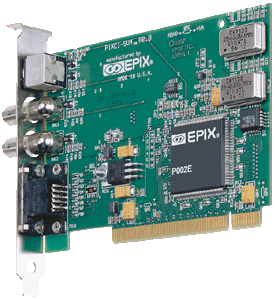
Imaging Board for the PCI Bus

|
| INNOVATIONS |
|
| APPLICATIONS |
|
The PIXCI® SV4 imaging board, for the PCI bus,
is designed to take advantage of the power of the host computer.
Applications which were once restricted by limited memory or processing
power can now be easily accomplished with the PIXCI® SV4
board and a compatible PCI computer.
ACQUISITION
A unique digital genlock circuit ensures precise synchronization
of every image. The PIXCI® SV4 board automatically recognizes
unstable signals (for example, from a VCR) and adapts its locking
mechanism to accommodate the source.
A multiplexer allows software selection of either a composite
or an S-Video source. Programmable automatic gain, hue, brightness,
saturation, and contrast adjustments condition the video signal.
Image sequences may be captured at full or reduced frame rates,
onto the PCI bus, for storage in the host computer's memory, or
passed to other devices on the PCI bus such as disk controllers
or VGA adapters.
SCALING AND CROPPING
The window of video to be captured may be cropped in single
pixel increments, then scaled in ratios from 1:1 to 1:14, down to
as few as 4 pixels by 1 line of image data. Horizontal and vertical
scaling is performed in real-time by interpolation, providing an
accurate representation of the original image.
DISPLAY
Depending on the VGA adapter, 24 bit RGB color images or 8 bit
monochrome images may be displayed. The full, scaled, or cropped
image may be placed anywhere on the VGA screen.
Luminance or monochrome image data can be passed directly to the
VGA for live video-in-a-window display. Color images are normally
stored in the host computer's memory, converted into RGB data, then
displayed on the VGA adapter. With a fast processor, fast PCI bus,
and fast VGA adapter, live color image data may be displayed. If
the VGA adapter can accept Y/C color pixels, then images can be
sent directly to the VGA adapter across the PCI bus.
TRANSFER RATES
The PIXCI® SV4 board is designed to use the 132 Mbytes/sec
burst mode transfer rate of the PCI bus. As a bus master, the PIXCI® SV4
board sends image data to the PCI bus; it does not wait for the
computer's CPU to read images from the board into PC memory.
I/O CONTROL
Four input and four output TTL trigger signals are available
for synchronization with external events.
SOFTWARE
Extensive software is available as a menu driven package for
DOS or Windows 95, Windows NT, or as programmer libraries. This
software provides capturing of images and image sequences, triggered
capture, scaling, cropping, image processing, measurement, analysis,
display, archiving, and graphing.
FEATURES
| MUX - The multiplexer selects the video source for
the Programmable Gain from either the S-Video input connector
or from the composite video source on the BNC connector. The
multiplexer may be switched during vertical blanking. Programmable Gain - Compensates for reduced amplitude
in the analog signal input. Gain can be programmed from 0%
to more than 200%. Luminance A/D - Provides analog to digital conversion
of NTSC, RS-170, CCIR, PAL, and the luminance (Y) component
of S-Video sources. Chrominance (Color) A/D - Provides analog to digital
conversion of the color (C) component of S-Video. |
Decoder - Separates the Y/C components. Generates the
U/V color difference signals. Digital Genlock - Automatic synchronization circuitry
for precise digitization. Accommodates video sources which
have variable periods, such as video tape recorders. Generates
the pixel clock for transferring image data to the PCI bus
interface. Scaling, Cropping - Interpolation is used to scale
images to 1/14 of their original size. Temporal Scaling - Image sequences may be captured
at full or reduced frame rates. Trigger I/O - Four input and four output TTL triggers
can be used for synchronization with external events. The
trigger signals are controlled by the host CPU. |

| SOFTWARE |
|
| XCIPLITE - A menu driven program for DOS or Windows,
providing capture, display, examination and graphing of image
data, and saving of images and graphs to file.
XCIP - A powerful, interactive, menu driven package
for DOS, Win-95, or Win-NT. XCIP has an extensive set of image
processing functions, and is easily enhanced with user-developed
custom menus and scripts. Features include image sequence
capture, triggered capture, display, processing, printing,
archiving, analysis, and calibrated measurement. Color and
monochrome processing is supported. (Optional) |
XCOBJ - Programmer's libraries providing easy board
access and control, such as video format and resolution selection,
image capture, and image memory access. Supports Watcom (32
bit) compiler with Tenberry DOS Extender, Win-95 DLL, or Win-NT
DLL. (Optional)
XCOBJIPL - All of the XCOBJ features plus an image processing library. Provides a wealth of ready-to-run functions for image enhancement, analysis, graphics, measurement, load/save, and printing. Supports Watcom (32 bit) compiler with Tenberry DOS Extender, Win-95 DLL, or Win-NT DLL. (Optional) |
SPECIFICATIONS
CONNECTIONS:
VIDEO INPUT:
DATA FORMATS TO PCI BUS:
|
TRANSFER RATES:
DISPLAY - Windows:
DISPLAY - DOS:
BUS REQUIREMENTS:
|
